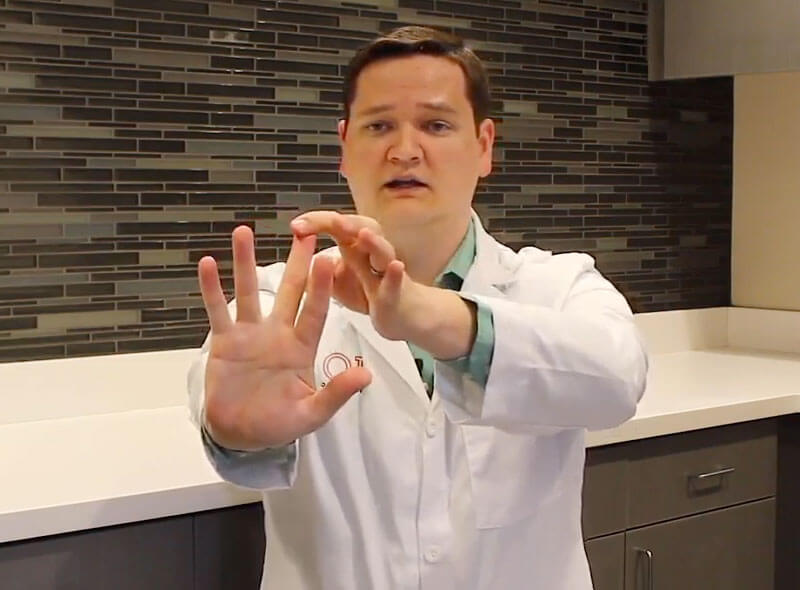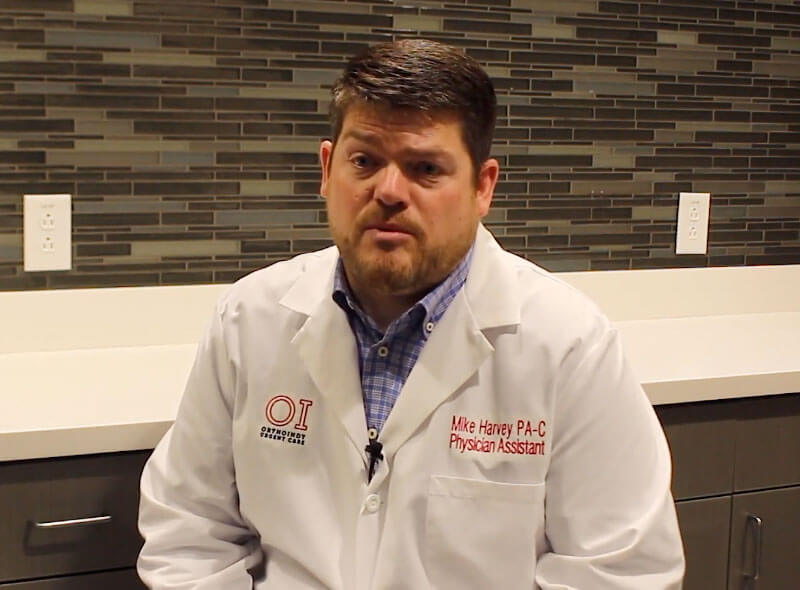The ultimate guide to
Hand, wrist and elbow injuries
Causes of pain, injury prevention and when to seek care from a doctor for finger, hand, wrist or elbow injuries

This guide discusses...
Relieve pain, recover quicker and prevent injury
Whether minor or severe, at one time or another, many of us have experienced an injury to the finger, hand, wrist or elbow. This is primarily a result of how often we use these body parts in our daily lives.
At OrthoIndy our hand, wrist and elbow specialists work as a team to make sure your injury doesn’t hold you or your child back from daily activities. From our urgent care clinics to our physical therapists, we focus on getting you back to work or your child back to sports.
Our Ultimate Guide to Hand, Wrist and Elbow Injuries provides everything you need to know about injuries to the fingers, hand, wrist or elbow including when to seek treatment, how to return to work after an injury and how to prevent common injuries.
1 Common finger, hand, wrist and elbow injuries and why you shouldn’t ignore the pain
No matter what we are doing, we generally use our hands all the time. Due to overuse from repetitive motion or an acute injury such as a fall or sports-related accident injuries to the fingers, hand, wrist or elbow are common.
Finger, hand, wrist or elbow injuries most commonly occur from:
- Work-related tasks
- Sports or recreational activities
- Projects around the home, especially using machinery such as lawn mowers, hand tools or deep cleaning
- Accidental falls
Most common finger, hand, wrist and elbow injuries
- Arthritis
- Broken elbow
- Broken finger
- Broken hand
- Broken wrist
- Carpal tunnel syndrome
- Compartment syndrome
- DeQuervain’s syndrome (wrist tendonitis)
- Distal humerus fractures of the elbow
- Elbow bursitis
- Elbow dislocation
- Elbow injuries in the throwing athlete
- Forearm fractures
- Ganglion cysts
- Golfer’s elbow
- Mallet finger
- Radial head fractures of the elbow
- Tennis elbow (elbow tendonitis)
- Thumb sprain (skier’s thumb/gamekeeper’s thumb)
- Trigger finger
- Ulnar tunnel syndrome
- Wrist sprain
Why you shouldn’t ignore finger, hand, elbow or wrist pain
Most of us have been groomed to ignore pain as long as possible in hopes that it goes away on its own. Whether it’s because we don’t want to sit on the sidelines during a sporting event or we can’t take time off work, it’s easy to make excuses on why you shouldn’t go to the doctor.
However, ignoring pain in the fingers, hand, wrist or elbow for a long period of time can cause increased damage and a longer treatment or recovery process in the end.

What happens if a fracture is left untreated?
While it is possible for a broken bone to heal on its own with splinting or bracing without the help of a medical professional, it could also lead to more problems or the need for surgery, which could’ve been avoided with treatment from a hand, wrist and elbow specialist.
For example, many people think “I may have broken my finger, but there is nothing that can be done so I am not going to waste my time at a doctor’s office.” However, improper splinting or at-home treatment for a broken finger can actually cause more pain, arthritis and even the need for surgery down the road.
Symptoms you shouldn’t ignore in the fingers, hand or wrist
- Tingling, numbness or weakness
- Stiffness, swelling and loss of movement
- Pain that lasts more than 48 hours
- Pain that is inconsistent or dull over a long period of time
- Trouble grasping objects or frequently dropping objects
READ MORE ABOUT WHY YOU SHOULDN’T IGNORE FINGER, HAND, ELBOW OR WRIST PAIN (BLOG ARTICLE)
common hand injuries in the workplace
- Lacerations
- Crushes
- Avulsions
- Detachments
- Punctures
- Fractures
2 At-home treatment and when to seek care from a doctor
When pain develops in your hand, wrist or elbow, it can be difficult to determine if you should seek professional treatment or assess your injury at home.
In the most basic terms, it all comes down to the amount of pain you are in and what your body is telling you. If something is obviously wrong, like you are unable to move your finger or rotate your wrist, you should seek medical care right away.
At-home treatment for hand, wrist or elbow pain
If pain is bearable and there is not an obvious deformity, at home treatment such as rest, ice or bracing may help relieve pain and swelling.
What if pain is dull, but still won’t go away?
Sometimes you or your child may experience hand, wrist or elbow pain that seemingly comes out of nowhere and lingers for a long period of time. If at home treatment methods don’t work or only work for a short period of time, you may need medical attention.
Conditions like tennis elbow, carpal tunnel or arthritis can have painful flare-ups for a period of time and then go away. These types of conditions need medical attention even if the pain isn’t urgent or consistent. It doesn’t mean you need surgery, you may just need physical therapy or other non-operative treatment methods to relieve pain.
It all comes down to assessing your pain and listening to what your body is telling you. If the pain isn’t acute, such as severe swelling and deformity after a sudden injury, you can probably avoid an emergency room visit.
If the pain is dull and goes away with at-home treatment you don’t need to follow-up with a medical professional. However, if the pain is consistent or comes and goes over a long period of time, it may be signs of an underlying condition and you should make an appointment with a hand, wrist and elbow specialist.
Download a Parent’s Guide to At-Home Treatment for Finger, Hand, Wrist or Elbow Injuries

Learn how to assess your child’s injury at home
Whether it’s a fall on an outstretched arm at the playground or a jammed finger at a basketball game, we share tips on how to treat these frequent injuries at-home and when to seek professional care.
When should you see a doctor for a wrist injury, elbow pain or finger injury?
Ask yourself a few questions about the pain you are feeling.
- Does it hurt when you press on it?
- Is it red, bruised or inflamed?
- Is it swollen, stiff or are you unable to move it?
- How would you rate your pain on a scale from 1 to 10 (1 minimal pain and 10 the worst pain you’ve experienced)?
If you answered yes to the first three questions and your pain is above a five, you should visit an urgent care clinic or make an appointment with a hand specialist. If your pain is low and improving, you can probably use at-home treatment methods to relieve pain.
Visit an OrthoIndy Urgent Care located throughout Indianapolis with weekend and evening hours or make an appointment with an OrthoIndy hand, wrist and elbow specialist.
3 What to expect during treatment and recovery
Treatment for a finger, hand, wrist or elbow injuries depends on the severity of the injury or pain, how long ago the injury occurred, your age and health, and your personal goals such as returning to work, sports or recreational activities.
For example, if you are experiencing wrist pain related to carpal tunnel, which gets in the way of your work, you may need to have surgery in order to lead a pain free life. However, if you have mild wrist pain and don’t require the constant use of your wrists, your doctor may recommend hand therapy to relieve pain.
Your hand, wrist and elbow specialist will determine the best course of treatment for you.
Most common treatment for finger, hand, wrist or elbow injuries or pain
- Buddy taping or the use of a brace, splint or cast
- Physical therapy
- Surgery
What to expect during recovery from a hand, wrist or elbow injury
A hand, wrist or elbow injury can be a seemingly small injury that has a huge impact on your daily activities. At times, recovery can be challenging and seem endless. However, it’s important to stay motivated to recover in order to return to your daily activities.

You do not need a referral to see an OrthoIndy occupational therapist. Our occupational therapists specialize in creating treatment plans for patients with hand, wrist or elbow injuries and are skilled at custom upper extremity splinting and brace fabrication.
The physical therapy team works with post-operative patients, as well as patients who do not require surgery, but are experiencing pain or injury.
Tips to recovery after a hand, wrist or elbow injury
- Stay positive: Coming back from an injury can be difficult and discouraging at times. However, it’s important to stay positive during recovery and rehabilitation.
- Expect difficulty: We use our hands for almost all of our daily activities, so not having one available can be frustrating. Don’t be afraid to ask for help and rely on others for tasks when necessary, such as driving, getting dressed or using the bathroom, and cooking and cleaning
- Expect swelling: Swelling is always present after injuries of the hand and wrist. To decrease swelling, elevate your injured hand and follow your hand exercises.
- Arrange your home: Stock up on straws, move items you regularly use in easy to reach spots and have chairs with armrests in rooms you typically sit in.
- Keep your dressing dry: Follow your doctor’s instructions for taking care of your dressing and bandages. Use a plastic bag to keep your dressings and bandages dry while showering.
Estimated recovery time for hand, wrist or elbow injuries
Broken bones take six to eight weeks to heal but full recovery from an injury to the hand or wrist can take four to six months, and sometimes even longer. It depends on the severity of the injury and the treatment method.
OrthoIndy Physical Therapy has certified hand therapists, also referred to as occupational therapists, that can assist you during your recovery process. A hand therapist will help you with exercises to regain movement and strength in your wrist or hand. They will also help you return to your daily activities and work tasks.
Read more about what to expect during recovery from a hand, wrist or elbow injury (Blog article)
4 How to avoid the ER and minimize your chance of injury
Elbow, hand or wrist pain isn’t normal. However with some occupations such as a painter, factory worker or athlete, overuse injuries seem inevitable; but there are steps you can take to reduce your risk of an overuse injury.
- Make corrections: Make sure your form and technique are correct when you are exercising or participating in a sport.
- Check your equipment: See if you are using the correct athletic gear or job-related equipment for your position or task.
- Take breaks: Take breaks from your sport to participate in other activities or regularly take breaks from your job-related tasks.
- Use a brace: Braces can take pressure off your hand, wrist or elbow and make it easier for you to heal or less likely for you to be injured.
If you notice symptoms of overuse injuries such as pain, numbness or a weakened grip you can try anti-inflammatory medicine like ibuprofen or use the R.I.C.E. (Rest. Ice. Compression. Elevate.) method to treat your injury at home.
Usually overuse injuries will heal on their own, however, if symptoms persist or worsen, make an appointment with a specialist right away.
Most common hand, wrist and elbow overuse injuries (repetitive strain injuries)
Elbow overuse injuries
Wrist overuse injuries
Hand pain from overuse
Read more about preventing overuse injuries of the hand, wrist or elbow (Blog article)
How can hand injuries be prevented at work?
According to the Bureau of Labor Statistics, the most common injuries in the workplace are sprains, strains and tears. This includes injuries to the wrist and hand ligament.
Hand injuries send more than one million workers to the emergency room each year. Many of these injuries required job restriction, job transfer or lost working days.
Be mindful of your workplace and take the extra steps to prevent injury part of your daily routine. Sometimes it can be tempting to ignore safety measures because you are trying to hurry and get a job done or you think a hand injury won’t happen to you after doing a job for many years. However, a hand injury can occur to anyone at any time.

How to prevent work-related injuries to the hand, wrist or elbow
No matter how many precautions we take, work-related injuries to the hand, wrist, finger or elbow seem inevitable. Here we discuss common hand injuries, the most common causes of workplace injuries and how to prevent them.
11 safety tips for preventing hand injuries in the workplace
- Wear appropriate safety gear such as work gloves when handling rough materials and when hands are directly involved with lifting or moving objects.
- Always use machinery guards.
- Replace machinery guard and lock machinery or confirm it is turned off before reaching into it.
- Remove trip hazards from worksites before beginning a job.
- Do not wear any rings when working as it could get caught in machinery or on an object.
- Wear gloves to pick up broken glass or nails.
- Wash hands frequently to remove grease and oil and prevent slippery hands.
- Be cautious when setting down items with your hands to make sure you have enough space or time to prevent crushing fingers.
- Never wear gloves around quick moving machinery which can catch on the glove and pull the hand into the machine.
- Remove protruding items such as nails, sharp edges or splinters before working.
- Do not wear gloves or loose clothing that doesn’t fit correctly; ask your employer for safety gear that fits appropriately.
 Dr. Matthew Walker, an OrthoIndy hand, wrist and elbow specialist shares carpal tunnel exercises you can do to relieve pain at home or while you work.
Dr. Matthew Walker, an OrthoIndy hand, wrist and elbow specialist shares carpal tunnel exercises you can do to relieve pain at home or while you work.
5 Is the cost of seeking treatment with a professional worth it?
When you know you have to have professional treatment for a finger, hand, wrist or elbow injury, paying for these new medical expenses can be worrisome. First, it’s important to check with your insurance provider to ensure OrthoIndy is in your network. OrthoIndy and OrthoIndy Hospital participates in most major insurance networks.
Many insurance companies have pricing tools that take into account your benefit plan. Visit your insurance provider’s website to see if this is available to calculate surgery costs.
6 Hand, wrist and elbow resources
Hand, wrist and elbow treatment at OrthoIndy
OrthoIndy specialists focus on treating your finger, hand, wrist or elbow injuries with the best options to keep you active in your daily activities. Whether it’s work, sports or recreational activities we want you to get your normal back.
Meet the doctors
Request an appointment
Downloadable guides
- The Ultimate Guide to Hand, Wrist or Elbow Injuries
- A parent’s guide to at-home treatment for finger, hand, wrist or elbow injuries
- Preventing work-related injuries to the hand, wrist or elbow
Blogs
- Why you shouldn’t ignore finger, hand, elbow or wrist pain
- Pain in your hand, wrist or elbow? When to seek help from a professional
- What to expect during recovery from a hand, wrist or elbow injury
- Preventing overuse injuries of the hand, wrist or elbow
Infographics
- Tips to pain relief at-home for finger, hand, wrist or elbow injuries
- When to seek professional care for a finger, hand, wrist or elbow injury






